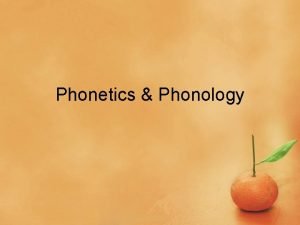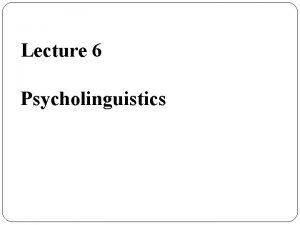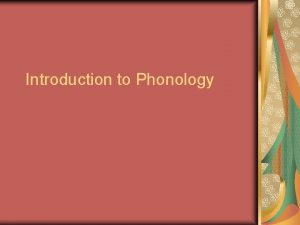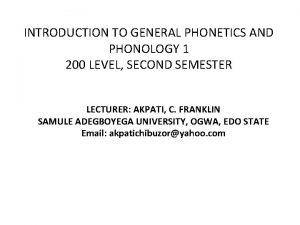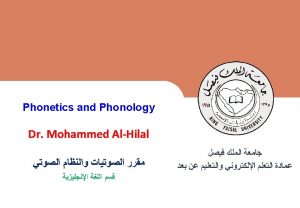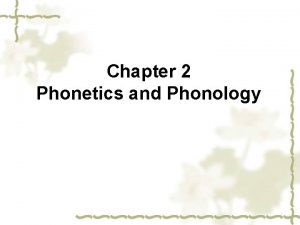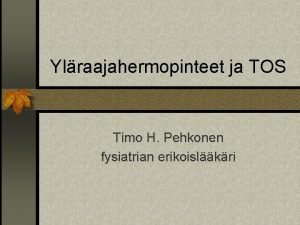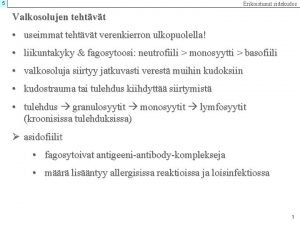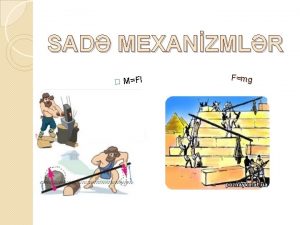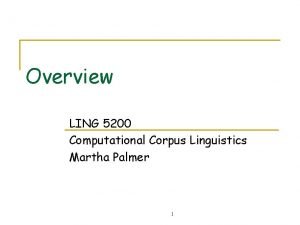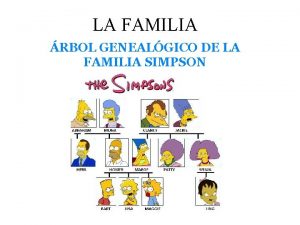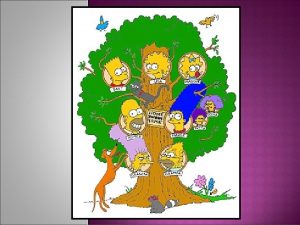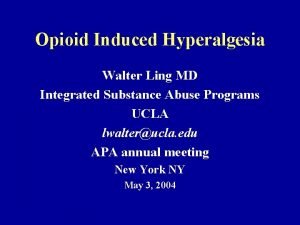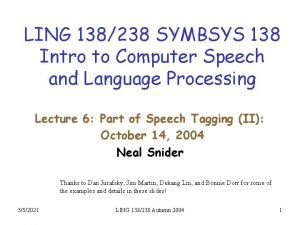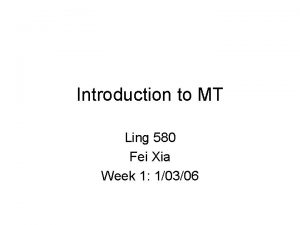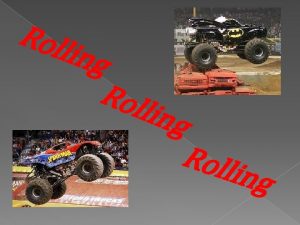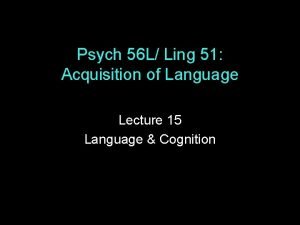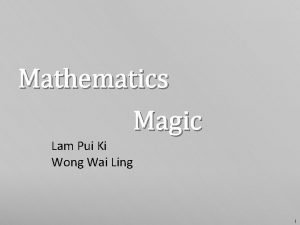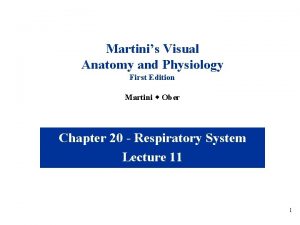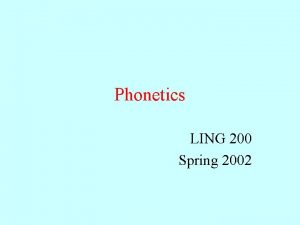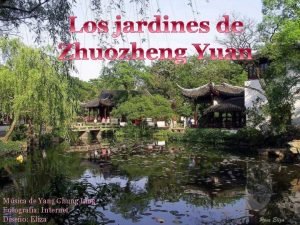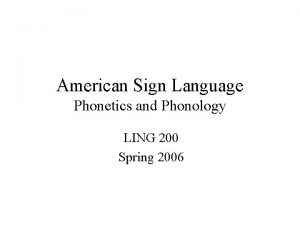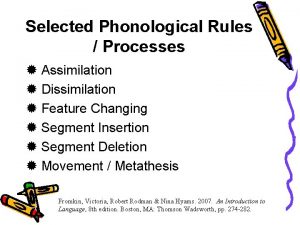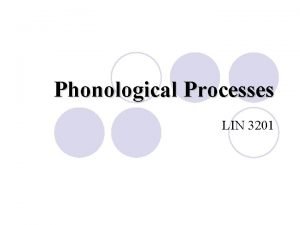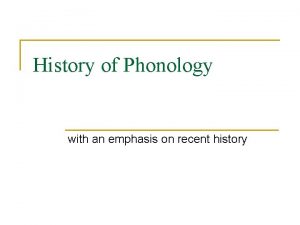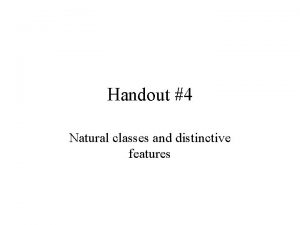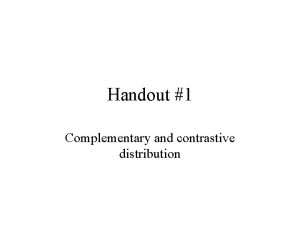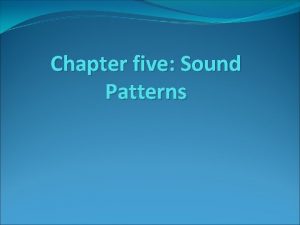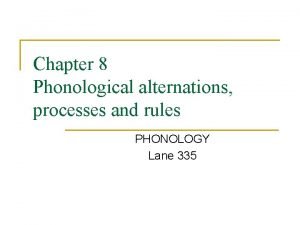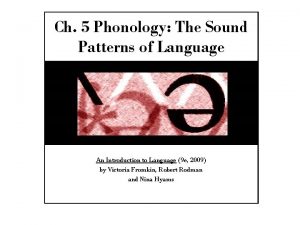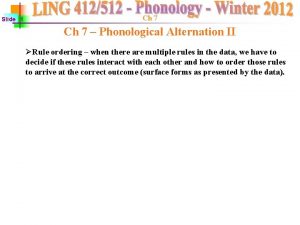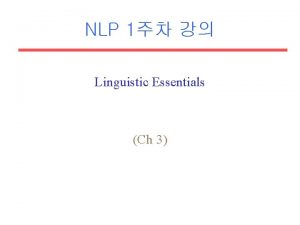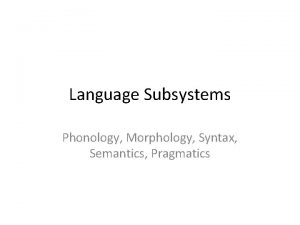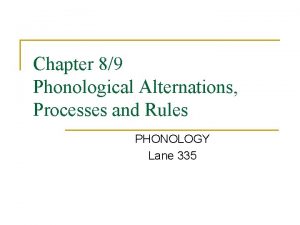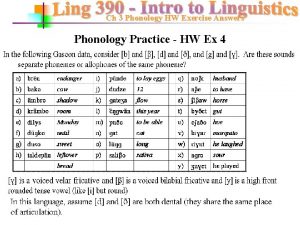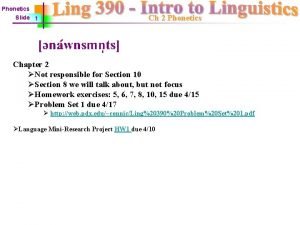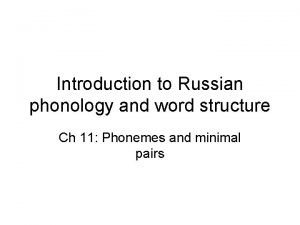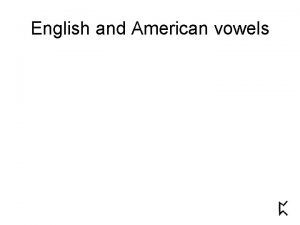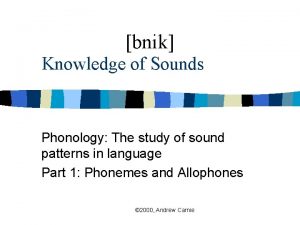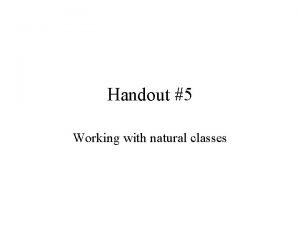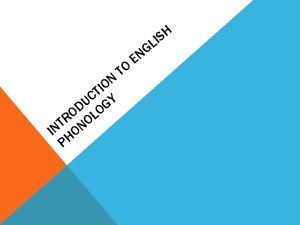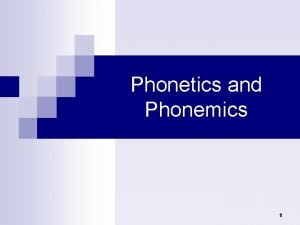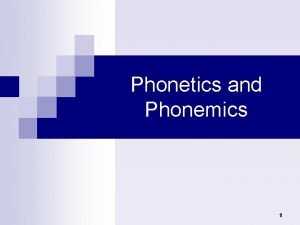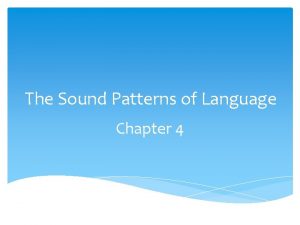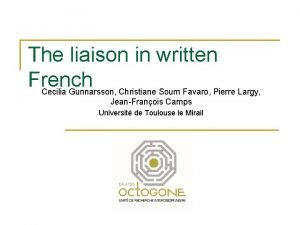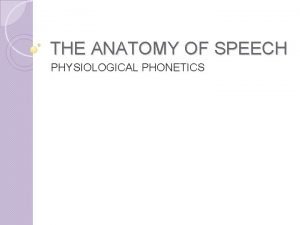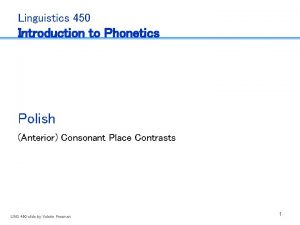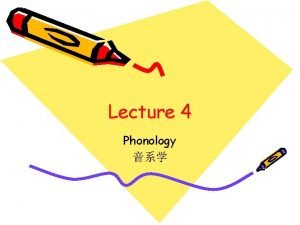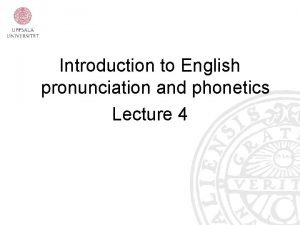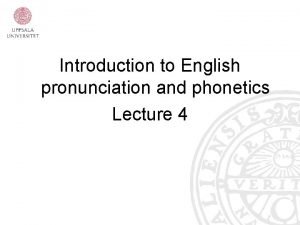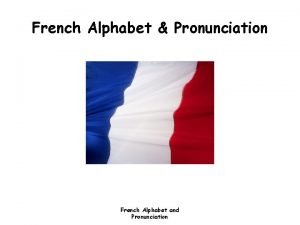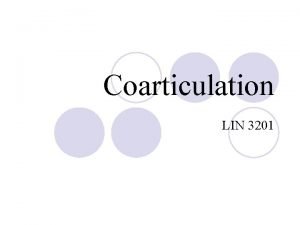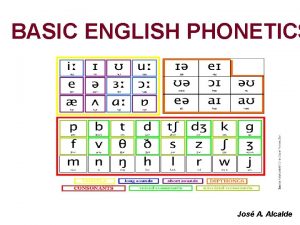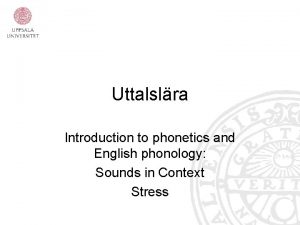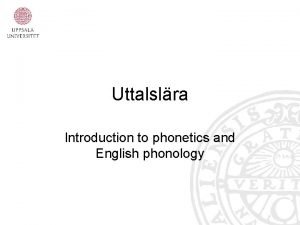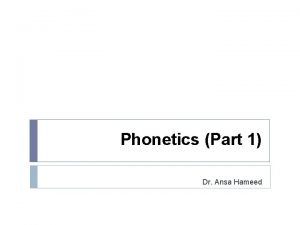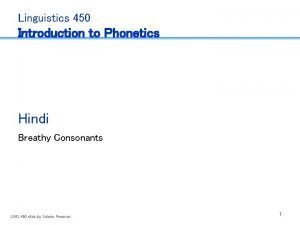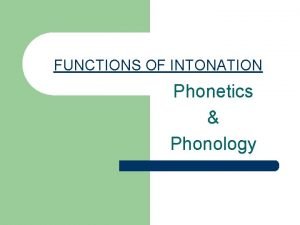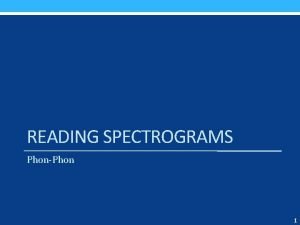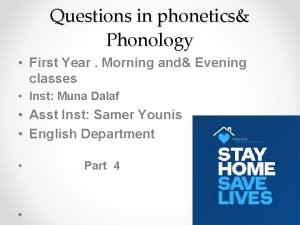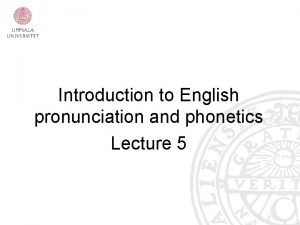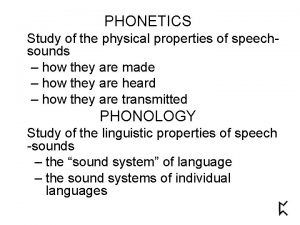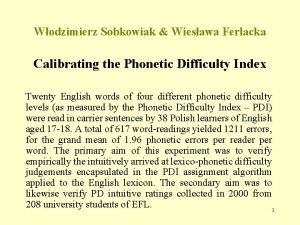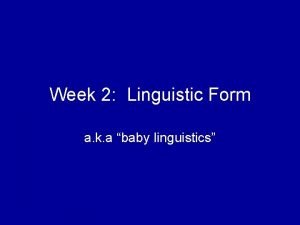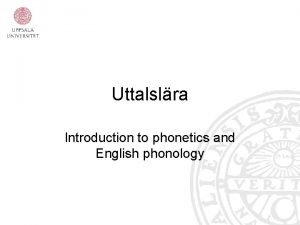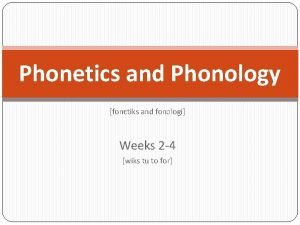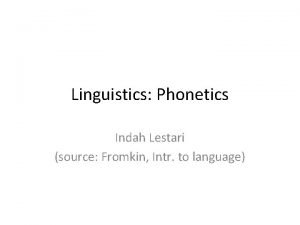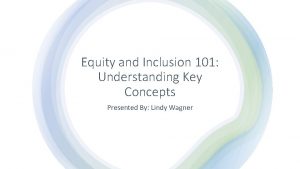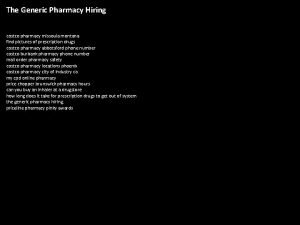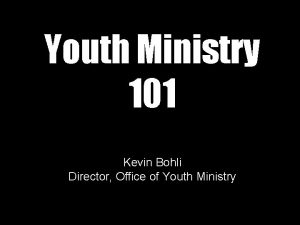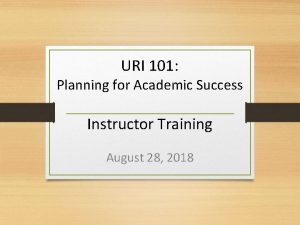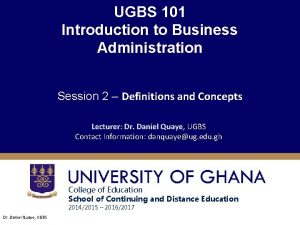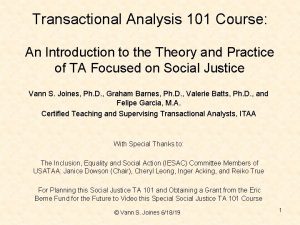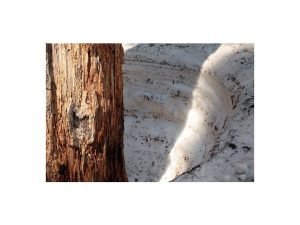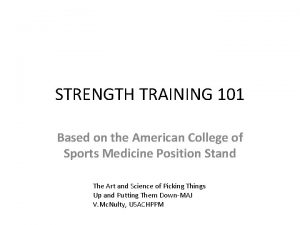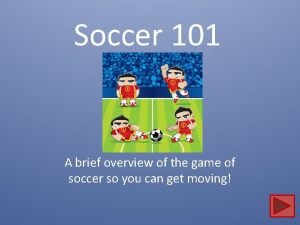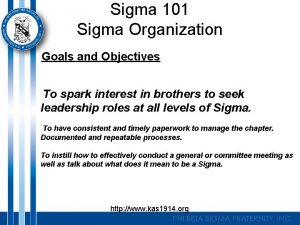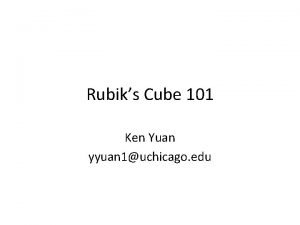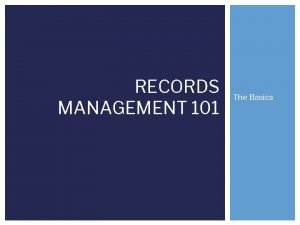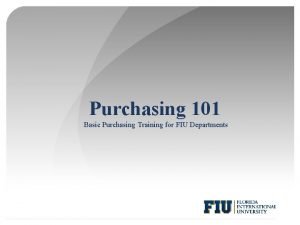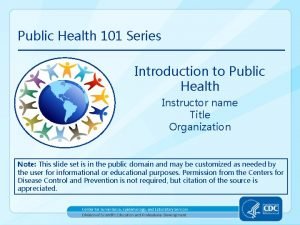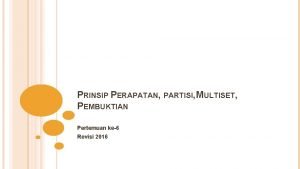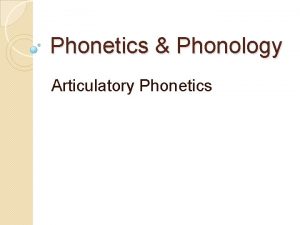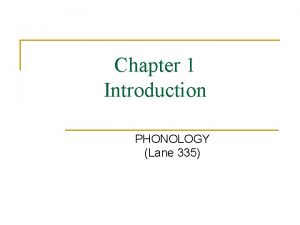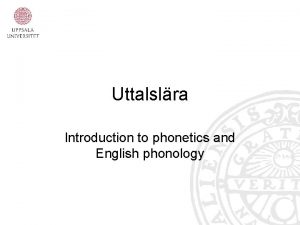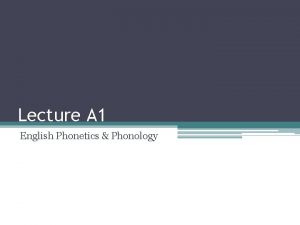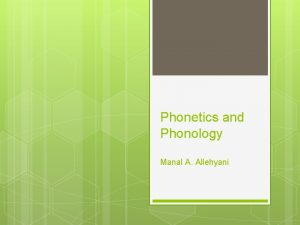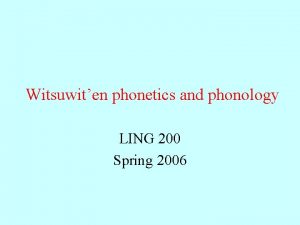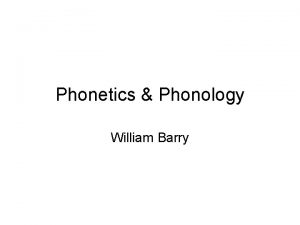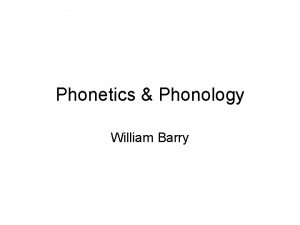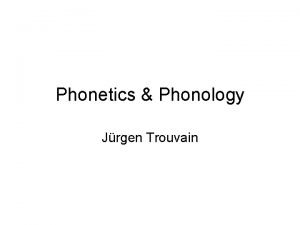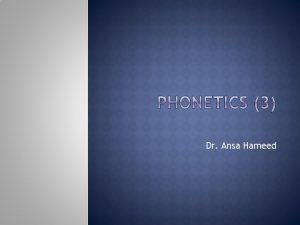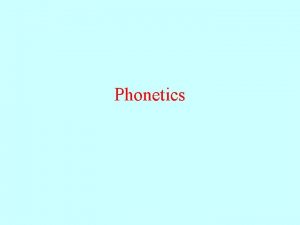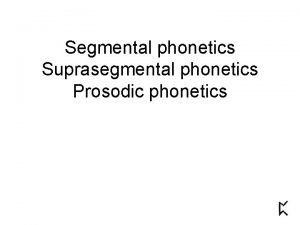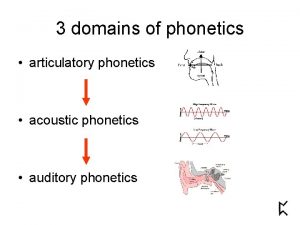Ling 101 Hermon Phonetics and Phonology 1 Phonetics










![Phonetics Goals: the IPA • Learn the (modified) IPA [International Phonetic Alphabet] symbols for Phonetics Goals: the IPA • Learn the (modified) IPA [International Phonetic Alphabet] symbols for](https://slidetodoc.com/presentation_image_h2/ae647b8c77ec6f68f0ae6f24c3003d48/image-11.jpg)
![Phonetics Goals: the IPA • Learn the (modified) IPA [International Phonetic Alphabet] symbols for Phonetics Goals: the IPA • Learn the (modified) IPA [International Phonetic Alphabet] symbols for](https://slidetodoc.com/presentation_image_h2/ae647b8c77ec6f68f0ae6f24c3003d48/image-12.jpg)
![Phonetics Goals: the IPA • Learn the IPA [International Phonetic Alphabet] symbols for English Phonetics Goals: the IPA • Learn the IPA [International Phonetic Alphabet] symbols for English](https://slidetodoc.com/presentation_image_h2/ae647b8c77ec6f68f0ae6f24c3003d48/image-13.jpg)









![Example: [i] as in key 23 Example: [i] as in key 23](https://slidetodoc.com/presentation_image_h2/ae647b8c77ec6f68f0ae6f24c3003d48/image-23.jpg)
![Example: [i] as in key • Tongue is high 24 Example: [i] as in key • Tongue is high 24](https://slidetodoc.com/presentation_image_h2/ae647b8c77ec6f68f0ae6f24c3003d48/image-24.jpg)
![Example: [i] as in key • Tongue is high • Tongue is front 25 Example: [i] as in key • Tongue is high • Tongue is front 25](https://slidetodoc.com/presentation_image_h2/ae647b8c77ec6f68f0ae6f24c3003d48/image-25.jpg)
![Example: [i] as in key • Tongue is high • Tongue is front • Example: [i] as in key • Tongue is high • Tongue is front •](https://slidetodoc.com/presentation_image_h2/ae647b8c77ec6f68f0ae6f24c3003d48/image-26.jpg)
![Example: [i] as in key • • Tongue is high Tongue is front Lips Example: [i] as in key • • Tongue is high Tongue is front Lips](https://slidetodoc.com/presentation_image_h2/ae647b8c77ec6f68f0ae6f24c3003d48/image-27.jpg)
![Description of [i] The vowel [i] is a high front tense unrounded vowel. 28 Description of [i] The vowel [i] is a high front tense unrounded vowel. 28](https://slidetodoc.com/presentation_image_h2/ae647b8c77ec6f68f0ae6f24c3003d48/image-28.jpg)
![Example: [a] as in Mom 29 Example: [a] as in Mom 29](https://slidetodoc.com/presentation_image_h2/ae647b8c77ec6f68f0ae6f24c3003d48/image-29.jpg)
![Example: [a] as in Mom • Tongue is low 30 Example: [a] as in Mom • Tongue is low 30](https://slidetodoc.com/presentation_image_h2/ae647b8c77ec6f68f0ae6f24c3003d48/image-30.jpg)
![Example: [a] as in Mom • Tongue is low • Tongue is back 31 Example: [a] as in Mom • Tongue is low • Tongue is back 31](https://slidetodoc.com/presentation_image_h2/ae647b8c77ec6f68f0ae6f24c3003d48/image-31.jpg)
![Example: [a] as in Mom • Tongue is low • Tongue is back • Example: [a] as in Mom • Tongue is low • Tongue is back •](https://slidetodoc.com/presentation_image_h2/ae647b8c77ec6f68f0ae6f24c3003d48/image-32.jpg)
![Example: [a] as in Mom • • Tongue is low Tongue is back Lips Example: [a] as in Mom • • Tongue is low Tongue is back Lips](https://slidetodoc.com/presentation_image_h2/ae647b8c77ec6f68f0ae6f24c3003d48/image-33.jpg)
![Example: [a] as in Mom [a] is a low back lax unrounded vowel 34 Example: [a] as in Mom [a] is a low back lax unrounded vowel 34](https://slidetodoc.com/presentation_image_h2/ae647b8c77ec6f68f0ae6f24c3003d48/image-34.jpg)
![Example: [ʊ] as in book 35 Example: [ʊ] as in book 35](https://slidetodoc.com/presentation_image_h2/ae647b8c77ec6f68f0ae6f24c3003d48/image-35.jpg)
![Example: [ʊ] as in book • Tongue is high 36 Example: [ʊ] as in book • Tongue is high 36](https://slidetodoc.com/presentation_image_h2/ae647b8c77ec6f68f0ae6f24c3003d48/image-36.jpg)
![Example: [ʊ] as in book • Tongue is high • Tongue is back 37 Example: [ʊ] as in book • Tongue is high • Tongue is back 37](https://slidetodoc.com/presentation_image_h2/ae647b8c77ec6f68f0ae6f24c3003d48/image-37.jpg)
![Example: [ʊ] as in book • Tongue is high • Tongue is back • Example: [ʊ] as in book • Tongue is high • Tongue is back •](https://slidetodoc.com/presentation_image_h2/ae647b8c77ec6f68f0ae6f24c3003d48/image-38.jpg)
![Example: [ʊ] as in book • • Tongue is high Tongue is back Lips Example: [ʊ] as in book • • Tongue is high Tongue is back Lips](https://slidetodoc.com/presentation_image_h2/ae647b8c77ec6f68f0ae6f24c3003d48/image-39.jpg)
![Example: [ʊ] as in book [ʊ] is a high back lax rounded vowel. 40 Example: [ʊ] as in book [ʊ] is a high back lax rounded vowel. 40](https://slidetodoc.com/presentation_image_h2/ae647b8c77ec6f68f0ae6f24c3003d48/image-40.jpg)
















































![Separate Sounds • English and Spanish both have the phones [i] and [ ] Separate Sounds • English and Spanish both have the phones [i] and [ ]](https://slidetodoc.com/presentation_image_h2/ae647b8c77ec6f68f0ae6f24c3003d48/image-89.jpg)
![Separate Sounds • English and Spanish both have the phones [i] and [ ] Separate Sounds • English and Spanish both have the phones [i] and [ ]](https://slidetodoc.com/presentation_image_h2/ae647b8c77ec6f68f0ae6f24c3003d48/image-90.jpg)
![Separate Sounds • English and Spanish both have the phones [i] and [ ] Separate Sounds • English and Spanish both have the phones [i] and [ ]](https://slidetodoc.com/presentation_image_h2/ae647b8c77ec6f68f0ae6f24c3003d48/image-91.jpg)


![English • [i] and [ ] are separate phonemes 94 English • [i] and [ ] are separate phonemes 94](https://slidetodoc.com/presentation_image_h2/ae647b8c77ec6f68f0ae6f24c3003d48/image-94.jpg)
![English • [i] and [ ] are separate phonemes • Different phonemes make different English • [i] and [ ] are separate phonemes • Different phonemes make different](https://slidetodoc.com/presentation_image_h2/ae647b8c77ec6f68f0ae6f24c3003d48/image-95.jpg)
![Spanish • [i] and [ ] are allophones of the same phoneme 96 Spanish • [i] and [ ] are allophones of the same phoneme 96](https://slidetodoc.com/presentation_image_h2/ae647b8c77ec6f68f0ae6f24c3003d48/image-96.jpg)
![Spanish • [i] and [ ] are allophones of the same phoneme • [i] Spanish • [i] and [ ] are allophones of the same phoneme • [i]](https://slidetodoc.com/presentation_image_h2/ae647b8c77ec6f68f0ae6f24c3003d48/image-97.jpg)
![Spanish • [i] and [ ] are allophones of the same phoneme • [i] Spanish • [i] and [ ] are allophones of the same phoneme • [i]](https://slidetodoc.com/presentation_image_h2/ae647b8c77ec6f68f0ae6f24c3003d48/image-98.jpg)







![Aspiration • [ph], [th] and [kh] mean that the stop consonant is pronounced with Aspiration • [ph], [th] and [kh] mean that the stop consonant is pronounced with](https://slidetodoc.com/presentation_image_h2/ae647b8c77ec6f68f0ae6f24c3003d48/image-106.jpg)
![Aspiration • [ph], [th] and [kh] mean that the stop consonant is pronounced with Aspiration • [ph], [th] and [kh] mean that the stop consonant is pronounced with](https://slidetodoc.com/presentation_image_h2/ae647b8c77ec6f68f0ae6f24c3003d48/image-107.jpg)















![Korean • [phal] • [pal] ‘arm’ ‘foot’ 123 Korean • [phal] • [pal] ‘arm’ ‘foot’ 123](https://slidetodoc.com/presentation_image_h2/ae647b8c77ec6f68f0ae6f24c3003d48/image-123.jpg)
![Korean • [tha] • [ta] ‘ride’ ‘all’ • [phi] • [pi] ‘blood’ ‘rain’ • Korean • [tha] • [ta] ‘ride’ ‘all’ • [phi] • [pi] ‘blood’ ‘rain’ •](https://slidetodoc.com/presentation_image_h2/ae647b8c77ec6f68f0ae6f24c3003d48/image-124.jpg)
![Korean • [phi] • [pi] ‘blood’ ‘rain’ • [khi] • [ki] ‘height’ ‘energy’ Are Korean • [phi] • [pi] ‘blood’ ‘rain’ • [khi] • [ki] ‘height’ ‘energy’ Are](https://slidetodoc.com/presentation_image_h2/ae647b8c77ec6f68f0ae6f24c3003d48/image-125.jpg)





![Free Variation • Sometimes sounds can be pronounced two ways – sip [s p] Free Variation • Sometimes sounds can be pronounced two ways – sip [s p]](https://slidetodoc.com/presentation_image_h2/ae647b8c77ec6f68f0ae6f24c3003d48/image-131.jpg)
![Free Variation • Sometimes sounds can be pronounced two ways – sip [s p] Free Variation • Sometimes sounds can be pronounced two ways – sip [s p]](https://slidetodoc.com/presentation_image_h2/ae647b8c77ec6f68f0ae6f24c3003d48/image-132.jpg)



![Phonological Rules /p/ [ph]/# _____ / # _____ = ‘is pronounced as’ = ‘when Phonological Rules /p/ [ph]/# _____ / # _____ = ‘is pronounced as’ = ‘when](https://slidetodoc.com/presentation_image_h2/ae647b8c77ec6f68f0ae6f24c3003d48/image-136.jpg)
![Phonological Rules /p/ [ph]/# _____ = ‘is pronounced as’ / = ‘when it is’ Phonological Rules /p/ [ph]/# _____ = ‘is pronounced as’ / = ‘when it is’](https://slidetodoc.com/presentation_image_h2/ae647b8c77ec6f68f0ae6f24c3003d48/image-137.jpg)




![Phones are combinations of distinctive features • The distinctive features of the vowel [a] Phones are combinations of distinctive features • The distinctive features of the vowel [a]](https://slidetodoc.com/presentation_image_h2/ae647b8c77ec6f68f0ae6f24c3003d48/image-142.jpg)
![Phones are combinations of distinctive features • The distinctive features of the vowel [a] Phones are combinations of distinctive features • The distinctive features of the vowel [a]](https://slidetodoc.com/presentation_image_h2/ae647b8c77ec6f68f0ae6f24c3003d48/image-143.jpg)
![Phones are combinations of distinctive features • The distinctive features of the vowel [a] Phones are combinations of distinctive features • The distinctive features of the vowel [a]](https://slidetodoc.com/presentation_image_h2/ae647b8c77ec6f68f0ae6f24c3003d48/image-144.jpg)
![Phones are combinations of distinctive features • The consonant [w] as in where is Phones are combinations of distinctive features • The consonant [w] as in where is](https://slidetodoc.com/presentation_image_h2/ae647b8c77ec6f68f0ae6f24c3003d48/image-145.jpg)






![The English Aspiration Rule +Consonantal -Vocalic +Stop -Voiced [+aspirated] #______ Voiceless stops are aspirated The English Aspiration Rule +Consonantal -Vocalic +Stop -Voiced [+aspirated] #______ Voiceless stops are aspirated](https://slidetodoc.com/presentation_image_h2/ae647b8c77ec6f68f0ae6f24c3003d48/image-152.jpg)
- Slides: 152

Ling 101, Hermon Phonetics and Phonology 1

Phonetics and Phonology • Phonetics: how sounds are produced and what their physical properties are 2

Phonetics and Phonology • Phonetics: how sounds are produced and what their physical properties are • Phonology: the organization of sounds in a language 3

Speech Production Mechanism 4

The Vocal Tract 5

States of the Glottis (Vocal Folds) 6

English Vowels 7

English Consonants 8

9

Phonetics: Goals Learn the International Phonetic Alphabet (IPA) as adapted to English. 10
![Phonetics Goals the IPA Learn the modified IPA International Phonetic Alphabet symbols for Phonetics Goals: the IPA • Learn the (modified) IPA [International Phonetic Alphabet] symbols for](https://slidetodoc.com/presentation_image_h2/ae647b8c77ec6f68f0ae6f24c3003d48/image-11.jpg)
Phonetics Goals: the IPA • Learn the (modified) IPA [International Phonetic Alphabet] symbols for English 11
![Phonetics Goals the IPA Learn the modified IPA International Phonetic Alphabet symbols for Phonetics Goals: the IPA • Learn the (modified) IPA [International Phonetic Alphabet] symbols for](https://slidetodoc.com/presentation_image_h2/ae647b8c77ec6f68f0ae6f24c3003d48/image-12.jpg)
Phonetics Goals: the IPA • Learn the (modified) IPA [International Phonetic Alphabet] symbols for English • Learn to read IPA with correct pronunciation of English words 12
![Phonetics Goals the IPA Learn the IPA International Phonetic Alphabet symbols for English Phonetics Goals: the IPA • Learn the IPA [International Phonetic Alphabet] symbols for English](https://slidetodoc.com/presentation_image_h2/ae647b8c77ec6f68f0ae6f24c3003d48/image-13.jpg)
Phonetics Goals: the IPA • Learn the IPA [International Phonetic Alphabet] symbols for English • Learn to read IPA with correct pronunciation of English words • Learn to transcribe English using IPA symbols 13

Phonetics Goals • Learn how English sounds are made • Learn how our anatomy influences how we make speech sounds 14

How are vowels made? 15

How are vowels made? • The glottis (vocal folds) hum as air passes out of the lungs 16

How are vowels made? • The glottis (vocal folds) hum like the strings of a violin as air passes out of the lungs • The shape of the vocal tract determines what vowel is heard. 17

How do we control, the shape of the vocal tract? • Tongue height 18

How do we control, the shape of the vocal tract? • Tongue height • Tongue advancement 19

How do we control, the shape of the vocal tract? • Tongue height • Tongue advancement • Lip rounding 20

How do we control, the shape of the vocal tract? • • Tongue height Tongue advancement Lip rounding Tenseness 21

The Result: 22
![Example i as in key 23 Example: [i] as in key 23](https://slidetodoc.com/presentation_image_h2/ae647b8c77ec6f68f0ae6f24c3003d48/image-23.jpg)
Example: [i] as in key 23
![Example i as in key Tongue is high 24 Example: [i] as in key • Tongue is high 24](https://slidetodoc.com/presentation_image_h2/ae647b8c77ec6f68f0ae6f24c3003d48/image-24.jpg)
Example: [i] as in key • Tongue is high 24
![Example i as in key Tongue is high Tongue is front 25 Example: [i] as in key • Tongue is high • Tongue is front 25](https://slidetodoc.com/presentation_image_h2/ae647b8c77ec6f68f0ae6f24c3003d48/image-25.jpg)
Example: [i] as in key • Tongue is high • Tongue is front 25
![Example i as in key Tongue is high Tongue is front Example: [i] as in key • Tongue is high • Tongue is front •](https://slidetodoc.com/presentation_image_h2/ae647b8c77ec6f68f0ae6f24c3003d48/image-26.jpg)
Example: [i] as in key • Tongue is high • Tongue is front • Lips are not rounded 26
![Example i as in key Tongue is high Tongue is front Lips Example: [i] as in key • • Tongue is high Tongue is front Lips](https://slidetodoc.com/presentation_image_h2/ae647b8c77ec6f68f0ae6f24c3003d48/image-27.jpg)
Example: [i] as in key • • Tongue is high Tongue is front Lips are not rounded Mouth is tense 27
![Description of i The vowel i is a high front tense unrounded vowel 28 Description of [i] The vowel [i] is a high front tense unrounded vowel. 28](https://slidetodoc.com/presentation_image_h2/ae647b8c77ec6f68f0ae6f24c3003d48/image-28.jpg)
Description of [i] The vowel [i] is a high front tense unrounded vowel. 28
![Example a as in Mom 29 Example: [a] as in Mom 29](https://slidetodoc.com/presentation_image_h2/ae647b8c77ec6f68f0ae6f24c3003d48/image-29.jpg)
Example: [a] as in Mom 29
![Example a as in Mom Tongue is low 30 Example: [a] as in Mom • Tongue is low 30](https://slidetodoc.com/presentation_image_h2/ae647b8c77ec6f68f0ae6f24c3003d48/image-30.jpg)
Example: [a] as in Mom • Tongue is low 30
![Example a as in Mom Tongue is low Tongue is back 31 Example: [a] as in Mom • Tongue is low • Tongue is back 31](https://slidetodoc.com/presentation_image_h2/ae647b8c77ec6f68f0ae6f24c3003d48/image-31.jpg)
Example: [a] as in Mom • Tongue is low • Tongue is back 31
![Example a as in Mom Tongue is low Tongue is back Example: [a] as in Mom • Tongue is low • Tongue is back •](https://slidetodoc.com/presentation_image_h2/ae647b8c77ec6f68f0ae6f24c3003d48/image-32.jpg)
Example: [a] as in Mom • Tongue is low • Tongue is back • Lips are not rounded 32
![Example a as in Mom Tongue is low Tongue is back Lips Example: [a] as in Mom • • Tongue is low Tongue is back Lips](https://slidetodoc.com/presentation_image_h2/ae647b8c77ec6f68f0ae6f24c3003d48/image-33.jpg)
Example: [a] as in Mom • • Tongue is low Tongue is back Lips are not rounded Mouth is not tense 33
![Example a as in Mom a is a low back lax unrounded vowel 34 Example: [a] as in Mom [a] is a low back lax unrounded vowel 34](https://slidetodoc.com/presentation_image_h2/ae647b8c77ec6f68f0ae6f24c3003d48/image-34.jpg)
Example: [a] as in Mom [a] is a low back lax unrounded vowel 34
![Example ʊ as in book 35 Example: [ʊ] as in book 35](https://slidetodoc.com/presentation_image_h2/ae647b8c77ec6f68f0ae6f24c3003d48/image-35.jpg)
Example: [ʊ] as in book 35
![Example ʊ as in book Tongue is high 36 Example: [ʊ] as in book • Tongue is high 36](https://slidetodoc.com/presentation_image_h2/ae647b8c77ec6f68f0ae6f24c3003d48/image-36.jpg)
Example: [ʊ] as in book • Tongue is high 36
![Example ʊ as in book Tongue is high Tongue is back 37 Example: [ʊ] as in book • Tongue is high • Tongue is back 37](https://slidetodoc.com/presentation_image_h2/ae647b8c77ec6f68f0ae6f24c3003d48/image-37.jpg)
Example: [ʊ] as in book • Tongue is high • Tongue is back 37
![Example ʊ as in book Tongue is high Tongue is back Example: [ʊ] as in book • Tongue is high • Tongue is back •](https://slidetodoc.com/presentation_image_h2/ae647b8c77ec6f68f0ae6f24c3003d48/image-38.jpg)
Example: [ʊ] as in book • Tongue is high • Tongue is back • Lips are rounded 38
![Example ʊ as in book Tongue is high Tongue is back Lips Example: [ʊ] as in book • • Tongue is high Tongue is back Lips](https://slidetodoc.com/presentation_image_h2/ae647b8c77ec6f68f0ae6f24c3003d48/image-39.jpg)
Example: [ʊ] as in book • • Tongue is high Tongue is back Lips are rounded Mouth is not tense 39
![Example ʊ as in book ʊ is a high back lax rounded vowel 40 Example: [ʊ] as in book [ʊ] is a high back lax rounded vowel. 40](https://slidetodoc.com/presentation_image_h2/ae647b8c77ec6f68f0ae6f24c3003d48/image-40.jpg)
Example: [ʊ] as in book [ʊ] is a high back lax rounded vowel. 40

How are consonants formed? 41

How are consonants formed? • Consonants are the beginning (onset) or end (offset) of vowels. 42

How are consonants formed? • Consonants are the beginning (onset) or end (offset) of vowels. • Consonants (often) block or interfere with the passing of air from the lungs. 43

How are consonants formed? Consonants can be more complicated than vowels. 44

Some Factors in Consonant Formation 45

Some Factors in Consonant Formation • State of the glottis (vocal folds) 46

Some Factors in Consonant Formation • State of the glottis (vocal folds) – Folds open (voiceless, no “hum”) 47

Some Factors in Consonant Formation • State of the glottis (vocal folds) – Folds open (voiceless, no “hum”) – Voiceless consonants like [p], [t] and [k] – Not voiced consonants like [b], [d] and [g] 48

Some Factors in Consonant Formation • State of the glottis (vocal folds) – Folds near each other (voiced, “humming”) 49

Some Factors in Consonant Formation • State of the glottis (vocal folds) – Folds near each other (voiced, “humming”) – Voiced consonants like [b], [z] and [n] 50

Some Factors in Consonant Formation • State of the glottis (vocal folds) • Place of articulation 51

Some Factors in Consonant Formation • State of the glottis (vocal folds) • Place of articulation – where is the air blocked or interfered with? 52

Some Factors in Consonant Formation • Place of articulation – where is the air blocked or interfered with? • [p]: The air is blocked at the two lips 53

Some Factors in Consonant Formation • Place of articulation – where is the air blocked or interfered with? • [p]: The air is blocked at the two lips • The place of articulation is bilabial 54

Some Factors in Consonant Formation • Places of articulation – Two lips (bilabial) 55

Some Factors in Consonant Formation • Places of articulation – Two lips (bilabial) – Lip and upper teeth (labiodental) 56

Some Factors in Consonant Formation • Places of articulation – Two lips (bilabial) – Lip and upper teeth (labiodental) – Between teeth (interdental) 57

Some Factors in Consonant Formation • Places of articulation – Two lips (bilabial) – Lip and upper teeth (labiodental) – Between teeth (interdental) – Alveolar ridge (alveolar) 58

Some Factors in Consonant Formation • Places of articulation – Two lips (bilabial) – Lip and upper teeth (labiodental) – Between teeth (interdental) – Alveolar ridge (alveolar) – Hard palate (palatal) 59

Some Factors in Consonant Formation • Places of articulation – Two lips (bilabial) – Lip and upper teeth (labiodental) – Between teeth (interdental) – Alveolar ridge (alveolar) – Hard palate (palatal) – Velum (velar) 60

Some Factors in Consonant Formation • Places of articulation – Two lips (bilabial) – Lip and upper teeth (labiodental) – Between teeth (interdental) – Alveolar ridge (alveolar) – Hard palate (palatal) – Velum (velar) – Glottis (glottal) 61

Some Factors in Consonant Formation • Manner of articulation 62

Some Factors in Consonant Formation • Manner of articulation – Stop: air passage blocked 63

Some Factors in Consonant Formation • Manner of articulation – Stop: air passage blocked [p], [b], [t], [d], [k], [g] 64

Some Factors in Consonant Formation • Manner of articulation – Stop – Affricate: air blocked and released 65

Some Factors in Consonant Formation • Manner of articulation – Stop – Affricate: air blocked and released: [c ], [ ] 66

Some Factors in Consonant Formation • Manner of articulation – Stop – Affricate – Fricative: air interfered with [f], [v], [s ] etc. 67

Some Factors in Consonant Formation • Manner of articulation – Stop – Affricate – Fricative • Together these are called Obstruents 68

Some Factors in Consonant Formation • Manner of articulation – Stop – Affricate – Fricative – Nasal 69

Some Factors in Consonant Formation • Manner of articulation – Stop – Affricate – Fricative – Nasal: [m], [n], [ ] 70

Some Factors in Consonant Formation • Manner of articulation – Stop – Affricate – Fricative – Nasal – Lateral Liquid 71

Some Factors in Consonant Formation • Manner of articulation – Stop – Affricate – Fricative – Nasal – Lateral Liquid: [l] 72

Some Factors in Consonant Formation • Manner of articulation – Stop – Affricate – Fricative – Nasal – Lateral Liquid – Retroflex Liquid 73

Some Factors in Consonant Formation • Manner of articulation – Stop – Affricate – Fricative – Nasal – Lateral Liquid – Retroflex Liquid: [r] 74

Some Factors in Consonant Formation • Manner of articulation – Stop – Affricate – Fricative – Nasal – Lateral Liquid – Retroflex Liquid – Glide 75

Some Factors in Consonant Formation • Manner of articulation – Stop – Affricate – Fricative – Nasal – Lateral Liquid – Retroflex Liquid – Glide: [w ], [w], [y] 76

Some Factors in Consonant Formation • Manner of articulation – Glide: Where is my book? [w r z may bʊk] 77

Classification of Consonants 78

Classification of Consonants • • • The classification can be read off the chart. [p] is a voiceless bilabial stop [y] is a voiced palatal glide [ ] is a voiced velar nasal etc. 79

Diphthongs • Two part vowel 80

Diphthongs • Two part vowel • Combination of vowel and glide 81

Diphthongs • Two part vowel • Combination of vowel and glide • Single syllable 82

Diphthongs • Two part vowel • Combination of vowel and glide • Single syllable e. g. [ay] as in buy [bay] [ey] as in bay [bey] [aw] as in cow [kaw] etc. 83

What you need to know about the classification of sounds • The categories that are used for vowels and consonants • What description [categorization] goes with each symbol 84

Phonology The Organization of Sounds in a Language 85

Phonology • Languages differ regarding which sounds speakers consider to be “separate sounds” 86

Phonology • Languages differ regarding which sounds speakers consider to be “separate sounds” • English: sit [s t] versus seat [sit] 87

Phonology • Languages differ regarding which sounds speakers consider to be “separate sounds” • English: sit [s t] versus seat [sit] • Spanish: sí ‘yes’ [si] versus singular ‘singular’ [s ngular] 88
![Separate Sounds English and Spanish both have the phones i and Separate Sounds • English and Spanish both have the phones [i] and [ ]](https://slidetodoc.com/presentation_image_h2/ae647b8c77ec6f68f0ae6f24c3003d48/image-89.jpg)
Separate Sounds • English and Spanish both have the phones [i] and [ ] 89
![Separate Sounds English and Spanish both have the phones i and Separate Sounds • English and Spanish both have the phones [i] and [ ]](https://slidetodoc.com/presentation_image_h2/ae647b8c77ec6f68f0ae6f24c3003d48/image-90.jpg)
Separate Sounds • English and Spanish both have the phones [i] and [ ] BUT 90
![Separate Sounds English and Spanish both have the phones i and Separate Sounds • English and Spanish both have the phones [i] and [ ]](https://slidetodoc.com/presentation_image_h2/ae647b8c77ec6f68f0ae6f24c3003d48/image-91.jpg)
Separate Sounds • English and Spanish both have the phones [i] and [ ] BUT • English speakers feel they are separate sounds • Spanish speakers feel they are the same sound 91

Why? ? ? 92

How are sounds organized differently in English and Spanish? 93
![English i and are separate phonemes 94 English • [i] and [ ] are separate phonemes 94](https://slidetodoc.com/presentation_image_h2/ae647b8c77ec6f68f0ae6f24c3003d48/image-94.jpg)
English • [i] and [ ] are separate phonemes 94
![English i and are separate phonemes Different phonemes make different English • [i] and [ ] are separate phonemes • Different phonemes make different](https://slidetodoc.com/presentation_image_h2/ae647b8c77ec6f68f0ae6f24c3003d48/image-95.jpg)
English • [i] and [ ] are separate phonemes • Different phonemes make different words. 95
![Spanish i and are allophones of the same phoneme 96 Spanish • [i] and [ ] are allophones of the same phoneme 96](https://slidetodoc.com/presentation_image_h2/ae647b8c77ec6f68f0ae6f24c3003d48/image-96.jpg)
Spanish • [i] and [ ] are allophones of the same phoneme 96
![Spanish i and are allophones of the same phoneme i Spanish • [i] and [ ] are allophones of the same phoneme • [i]](https://slidetodoc.com/presentation_image_h2/ae647b8c77ec6f68f0ae6f24c3003d48/image-97.jpg)
Spanish • [i] and [ ] are allophones of the same phoneme • [i] and [ ] are used in different places in a word 97
![Spanish i and are allophones of the same phoneme i Spanish • [i] and [ ] are allophones of the same phoneme • [i]](https://slidetodoc.com/presentation_image_h2/ae647b8c77ec6f68f0ae6f24c3003d48/image-98.jpg)
Spanish • [i] and [ ] are allophones of the same phoneme • [i] and [ ] are used in different places in a word – [i] when the syllable ends in a vowel – [I] when the syllable ends in a consonant 98

English 99

Spanish 100

Spanish versus English • One phoneme • Two allophones of that phoneme • Two separate phonemes • Each phoneme has one allophone 101

Phonemes and their Allophones 102

Phonemes and their Allophones • Different allophones of a phoneme usually occur in different places in the word 103

Phonemes and their Allophones • Different allophones of a phoneme usually occur in different places in the word • English voiceless stop phonemes (/p/, /t/ and /k/) have a special allophone at the beginning of the word 104

Phonemes and their Allophones • Different allophones of a phoneme usually occur in different places in the word • English voiceless stops (/p/, /t/ and /k/) have a special allophone at the beginning of the word – pop [phap] – tot [that] – cock [khak] 105
![Aspiration ph th and kh mean that the stop consonant is pronounced with Aspiration • [ph], [th] and [kh] mean that the stop consonant is pronounced with](https://slidetodoc.com/presentation_image_h2/ae647b8c77ec6f68f0ae6f24c3003d48/image-106.jpg)
Aspiration • [ph], [th] and [kh] mean that the stop consonant is pronounced with a puff of air 106
![Aspiration ph th and kh mean that the stop consonant is pronounced with Aspiration • [ph], [th] and [kh] mean that the stop consonant is pronounced with](https://slidetodoc.com/presentation_image_h2/ae647b8c77ec6f68f0ae6f24c3003d48/image-107.jpg)
Aspiration • [ph], [th] and [kh] mean that the stop consonant is pronounced with a puff of air • These are aspirated stops 107

Are English aspirated stops separate phonemes from unaspirated stops? • Is there a specific environment in which aspirated stops occur? 108

Are English aspirated stops separate phonemes from unaspirated stops? • Is there a specific environment in which aspirated stops occur? • Does the choice of aspirated or unaspirated stop change what word is being pronounced? 109

Are English aspirated stops separate phonemes from unaspirated stops? • Is there a specific environment in which aspirated stops occur? YES! 110

Are English aspirated stops separate phonemes from unaspirated stops? • Does the choice of aspirated or unaspirated stop change what word is being pronounced? NO! 111

Are English aspirated stops separate phonemes from unaspirated stops? • Is there a specific environment in which aspirated stops occur? YES! • Does the choice of aspirated or unaspirated stop change what word is being pronounced? NO! 112

Are English aspirated stops separate phonemes from unaspirated stops? • Thus, aspirated and unaspirated stops are not separate phonemes. 113

Are English aspirated stops separate phonemes from unaspirated stops? • Thus, aspirated and unaspirated stops are not separate phonemes. • They are both allophones of the same phoneme. 114

English Aspirated Stops • Complementary distribution • Don’t affect meaning Thus: allophones of the same phoneme. 115

Allophones of Same Phoneme • Complementary distribution • Don’t affect meaning 116

Separate Phonemes 117

Separate Phonemes • Contrastive distribution 118

Separate Phonemes • Contrastive distribution – occur in same position in word 119

Separate Phonemes • Contrastive distribution – occur in same position in word • Change meaning 120

English versus Korean 121

English versus Korean • Both have voiceless aspirated consonants as phones • Are Korean voiceless aspirated stops separate phonemes from voiceless unaspirated stops? 122
![Korean phal pal arm foot 123 Korean • [phal] • [pal] ‘arm’ ‘foot’ 123](https://slidetodoc.com/presentation_image_h2/ae647b8c77ec6f68f0ae6f24c3003d48/image-123.jpg)
Korean • [phal] • [pal] ‘arm’ ‘foot’ 123
![Korean tha ta ride all phi pi blood rain Korean • [tha] • [ta] ‘ride’ ‘all’ • [phi] • [pi] ‘blood’ ‘rain’ •](https://slidetodoc.com/presentation_image_h2/ae647b8c77ec6f68f0ae6f24c3003d48/image-124.jpg)
Korean • [tha] • [ta] ‘ride’ ‘all’ • [phi] • [pi] ‘blood’ ‘rain’ • [khi] • [ki] ‘height’ ‘energy’ 124
![Korean phi pi blood rain khi ki height energy Are Korean • [phi] • [pi] ‘blood’ ‘rain’ • [khi] • [ki] ‘height’ ‘energy’ Are](https://slidetodoc.com/presentation_image_h2/ae647b8c77ec6f68f0ae6f24c3003d48/image-125.jpg)
Korean • [phi] • [pi] ‘blood’ ‘rain’ • [khi] • [ki] ‘height’ ‘energy’ Are aspirated and unaspirated stops in complementary or contrastive distribution in Korean? 125

Korean Are aspirated and unaspirated stops in complementary or contrastive distribution in Korean? Contrastive distribution 126

Korean • Are unaspirated and aspirated voiceless stops separate phonemes or allophones of the same phoneme? They are separate phonemes. 127

Because Korean aspirated and unaspirated stops are in contrastive distribution they are separate phonemes 128

English Because English aspirated and unaspirated stop consonants are in complementary distribution they are allophones of the same phoneme 129

Free Variation 130
![Free Variation Sometimes sounds can be pronounced two ways sip s p Free Variation • Sometimes sounds can be pronounced two ways – sip [s p]](https://slidetodoc.com/presentation_image_h2/ae647b8c77ec6f68f0ae6f24c3003d48/image-131.jpg)
Free Variation • Sometimes sounds can be pronounced two ways – sip [s p] [s ph] 131
![Free Variation Sometimes sounds can be pronounced two ways sip s p Free Variation • Sometimes sounds can be pronounced two ways – sip [s p]](https://slidetodoc.com/presentation_image_h2/ae647b8c77ec6f68f0ae6f24c3003d48/image-132.jpg)
Free Variation • Sometimes sounds can be pronounced two ways – sip [s p] [s ph] • Meaning same • Free variation 132

Free Variation • Phones in free variation are allophones of the same phoneme • Phones in free variation are not separate phonemes 133

Phonological Rules 134

Phonological Rules • Phonological rules connect phonemes to their allophones: – Rule: The phoneme /p/ is pronounced as the phone [ph] when it occurs at the beginning of a word. – More formally: /p/ [ph]/# _____ 135
![Phonological Rules p ph is pronounced as when Phonological Rules /p/ [ph]/# _____ / # _____ = ‘is pronounced as’ = ‘when](https://slidetodoc.com/presentation_image_h2/ae647b8c77ec6f68f0ae6f24c3003d48/image-136.jpg)
Phonological Rules /p/ [ph]/# _____ / # _____ = ‘is pronounced as’ = ‘when it is’ = ‘beginning or end of word’ = ‘the position of the phoneme in question’ 136
![Phonological Rules p ph is pronounced as when it is Phonological Rules /p/ [ph]/# _____ = ‘is pronounced as’ / = ‘when it is’](https://slidetodoc.com/presentation_image_h2/ae647b8c77ec6f68f0ae6f24c3003d48/image-137.jpg)
Phonological Rules /p/ [ph]/# _____ = ‘is pronounced as’ / = ‘when it is’ # = ‘beginning or end of word’ __ = ‘the position of the phoneme in question’ The phoneme /p/ is pronounced as [ph] when it is at the beginning of a word. 137

Distinctive Features 138

Distinctive Features Are phones the “atoms” of phonology? 139

Distinctive Features Can phones be broken down into smaller parts? 140

Phones are combinations of distinctive features 141
![Phones are combinations of distinctive features The distinctive features of the vowel a Phones are combinations of distinctive features • The distinctive features of the vowel [a]](https://slidetodoc.com/presentation_image_h2/ae647b8c77ec6f68f0ae6f24c3003d48/image-142.jpg)
Phones are combinations of distinctive features • The distinctive features of the vowel [a] [+vocalic, -consonantal, +low, +back, +lax] 142
![Phones are combinations of distinctive features The distinctive features of the vowel a Phones are combinations of distinctive features • The distinctive features of the vowel [a]](https://slidetodoc.com/presentation_image_h2/ae647b8c77ec6f68f0ae6f24c3003d48/image-143.jpg)
Phones are combinations of distinctive features • The distinctive features of the vowel [a] [+vocalic, -consonantal, +low, +back, +lax] • You can read the distinctive features off the chart of vowels: 143
![Phones are combinations of distinctive features The distinctive features of the vowel a Phones are combinations of distinctive features • The distinctive features of the vowel [a]](https://slidetodoc.com/presentation_image_h2/ae647b8c77ec6f68f0ae6f24c3003d48/image-144.jpg)
Phones are combinations of distinctive features • The distinctive features of the vowel [a] – [+vocalic, -consonantal, +low, +back, +lax, unrounded] • You can read the distinctive features off the chart of vowels: 144
![Phones are combinations of distinctive features The consonant w as in where is Phones are combinations of distinctive features • The consonant [w] as in where is](https://slidetodoc.com/presentation_image_h2/ae647b8c77ec6f68f0ae6f24c3003d48/image-145.jpg)
Phones are combinations of distinctive features • The consonant [w] as in where is composed of the following distinctive features: – [+consonantal, -vocalic, +glide, -voiced] • The distinctive features can be read off the consonant chart (More advanced courses may use different feature sets that cannot be read off the charts. ) 145

Phonological rules use distinctive features to capture generalizations 146

The English Aspiration Rule • p • t • k ph/# _____ th/#______ kh/#______ 147

The English Aspiration Rule • p • t • k ph/# _____ th/#______ kh/#______ Does this miss a generalization? YES!!! 148

The English Aspiration Rule • p • t • k ph/# _____ th/#______ kh/#______ [p], [t], [k] are all voiceless stops. 149

The English Aspiration Rule • p • t • k ph/# _____ th/#______ kh/#______ [p], [t], [k] are all voiceless stops. Voiceless stops are aspirated when they are in the beginning of the word. 150

The English Aspiration Rule • • p ph/# _____ t th/#______ k kh/#______ Voiceless stops are aspirated when they are in the beginning of the word. +Consonantal -Vocalic +Stop -Voiced [+aspirated] #______ 151
![The English Aspiration Rule Consonantal Vocalic Stop Voiced aspirated Voiceless stops are aspirated The English Aspiration Rule +Consonantal -Vocalic +Stop -Voiced [+aspirated] #______ Voiceless stops are aspirated](https://slidetodoc.com/presentation_image_h2/ae647b8c77ec6f68f0ae6f24c3003d48/image-152.jpg)
The English Aspiration Rule +Consonantal -Vocalic +Stop -Voiced [+aspirated] #______ Voiceless stops are aspirated when they are in the beginning of the word. By expressing the rule in terms of distinctive features we can capture the scientific generalization 152
 Articulation of phonemes
Articulation of phonemes Differences between phonetics and phonology
Differences between phonetics and phonology Phonological rule
Phonological rule Phonetics and phonology
Phonetics and phonology Answer key
Answer key Drc model of reading
Drc model of reading What is phonology in linguistics
What is phonology in linguistics Introduction to general phonetics and phonology
Introduction to general phonetics and phonology The difference between phonetics and phonology
The difference between phonetics and phonology Cardinal vowels
Cardinal vowels Phonetics and phonology
Phonetics and phonology Assimilation linguistics
Assimilation linguistics Phonetics vs phonology
Phonetics vs phonology Nervus radialis pinne
Nervus radialis pinne Epineurium
Epineurium Discourse analysis and phonology
Discourse analysis and phonology Segmental and suprasegmental phonology examples
Segmental and suprasegmental phonology examples Jin ling cigarettes
Jin ling cigarettes Tərpənən tərpənməz blok
Tərpənən tərpənməz blok Ling
Ling Erin ling
Erin ling Ling oa
Ling oa Mei-ling from singapore was preparing
Mei-ling from singapore was preparing Primos
Primos Dr ng li ling
Dr ng li ling Nien-ling wacker
Nien-ling wacker 施玲玲
施玲玲 Ling simpson
Ling simpson Graph4ai
Graph4ai He specialized in military gymnastics.
He specialized in military gymnastics. Walter ling
Walter ling Ling
Ling Ling138
Ling138 Ling
Ling Mt ling
Mt ling Wai ling lam
Wai ling lam Ling oa
Ling oa Wang ling relationship
Wang ling relationship Huo lingyu
Huo lingyu Ling roll
Ling roll Fossa ovalis
Fossa ovalis False belief test
False belief test Cheung yin ling
Cheung yin ling Magic lam
Magic lam Tree in lung picture
Tree in lung picture Short term goal
Short term goal Mei-ling huang
Mei-ling huang Ling 200
Ling 200 Ling internet
Ling internet Agnes ling
Agnes ling Ling 100
Ling 100 Ida ling
Ida ling Ling 200
Ling 200 Assimilation rules in phonology
Assimilation rules in phonology Coda onset
Coda onset Phonology
Phonology Assimilation rules in phonology
Assimilation rules in phonology Non segmental phonology
Non segmental phonology Autosegmental phonology
Autosegmental phonology Manner features
Manner features Complementary distribution definition
Complementary distribution definition Distinctive features phonology
Distinctive features phonology Phonology process
Phonology process Assimilation in phonology
Assimilation in phonology Alternation in phonology
Alternation in phonology Natural classes phonology
Natural classes phonology Example phonology
Example phonology Linking in phonology
Linking in phonology Subsystems of language
Subsystems of language Alpha notation phonology
Alpha notation phonology Phonology exercises with answers
Phonology exercises with answers Phonology process
Phonology process Russian phonology
Russian phonology Quenya phonology
Quenya phonology American english phonology
American english phonology Complementary distribution examples
Complementary distribution examples What is recursion in language
What is recursion in language Minimal pairs examples
Minimal pairs examples Palabras en chatino
Palabras en chatino Segmental phonology
Segmental phonology Definition of consonants
Definition of consonants N phonetics
N phonetics What are sound patterns that have meaning
What are sound patterns that have meaning Cecilia gunnarsson
Cecilia gunnarsson Phonetic anatomy
Phonetic anatomy Vowel sound phonetics
Vowel sound phonetics Articulatory organs
Articulatory organs Anterior consonant
Anterior consonant Coarticulation in phonetics
Coarticulation in phonetics Examples of elision
Examples of elision Wɒʃt
Wɒʃt French alphabets a-z with pronunciation
French alphabets a-z with pronunciation Coarticulation in phonetics
Coarticulation in phonetics Alcalde pronunciation
Alcalde pronunciation Regressive assimilation examples
Regressive assimilation examples Arthur the rat phonetic transcription
Arthur the rat phonetic transcription Obstruent consonants
Obstruent consonants Hindi consonant chart
Hindi consonant chart Falling intonation symbol
Falling intonation symbol Phonetics chinese
Phonetics chinese Fricatives
Fricatives Questions about phonetics
Questions about phonetics Rp =
Rp = Phonostylistics as a branch of phonetics
Phonostylistics as a branch of phonetics Praat doing phonetics by computer
Praat doing phonetics by computer Cat
Cat Ucla phonetics lab
Ucla phonetics lab Weslande taxi
Weslande taxi Police alphabet
Police alphabet Auditory phonetics
Auditory phonetics Gradation phonetics
Gradation phonetics Dental phonetics
Dental phonetics Suprasegmental phonemes examples
Suprasegmental phonemes examples Assimilation in phonetics
Assimilation in phonetics Dental phonetics
Dental phonetics Language
Language Definition of phonetics
Definition of phonetics English ipa alphabet
English ipa alphabet Phonetics basics
Phonetics basics Diversity equity and inclusion 101
Diversity equity and inclusion 101 Data lake 101
Data lake 101 Costco pharmacy sf
Costco pharmacy sf How many prime numbers between 1 and 100
How many prime numbers between 1 and 100 Youth ministry 101
Youth ministry 101 Wipo worldwide academy
Wipo worldwide academy Ocs architecture
Ocs architecture Stem robotics 101
Stem robotics 101 Physics 101 uiuc
Physics 101 uiuc Cisc 101
Cisc 101 Accounts payable 101
Accounts payable 101 Uri academic advisors
Uri academic advisors Unix 101
Unix 101 Ugbs 101
Ugbs 101 Tcp 101
Tcp 101 Transactional analysis 101
Transactional analysis 101 101 computing network design
101 computing network design Greenhouse effect
Greenhouse effect Equipment leasing 101
Equipment leasing 101 Hadoop 101
Hadoop 101 Mats selen uiuc
Mats selen uiuc Weight training 101
Weight training 101 Sql server 101
Sql server 101 Universal design for learning definition
Universal design for learning definition Christopher wiig
Christopher wiig Soccer 101 game
Soccer 101 game Sigma 101
Sigma 101 Rubik's cube 101
Rubik's cube 101 Records management 101
Records management 101 Oba-101
Oba-101 Procurement 101 training
Procurement 101 training Fiu vendor registration
Fiu vendor registration Public health 101
Public health 101 Diantara bilangan bulat antara 101 - 600
Diantara bilangan bulat antara 101 - 600



